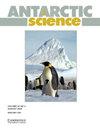新冰川期和其他环境变化对南极Joinville岛凸起海滩的影响
IF 2
4区 地球科学
Q3 ENVIRONMENTAL SCIENCES
引用次数: 0
摘要
为了重建南极半岛东北部过去的环境条件,我们记录了在Joinville岛(Joinville Island)过去~7.7±0.9 ka发展的36个凸起海滩上,通过探地雷达反射剖面和冰筏碎片观察到的颗粒大小、颗粒圆度、覆盖度的变化。在~2.7 ~ 3.0 ka时,滩性变化最为明显。此时,似乎又出现了不太圆的物质,个别海滩山脊内分层的发展,海藻和帽贝被引入海滩沉积物,碎屑来源的变化(尽管比鹅卵石圆度的变化略早)和整个海滩平原斜坡的变浅。与新冰川期相关的长期降温可能促成了这些变化,因为冰川的推进可能改变了海滩沉积物的来源,并引入了更多的物质,导致海滩鹅卵石的圆度和海滩平原的整体坡度发生了变化。该研究表明,全新世晚期的环境变化对南极洲沿海地区产生了可测量的影响。本文章由计算机程序翻译,如有差异,请以英文原文为准。
The impact of the Neoglacial and other environmental changes on the raised beaches of Joinville Island, Antarctica
Abstract In order to reconstruct past environmental conditions along the north-eastern Antarctic Peninsula, we documented changes in grain size, grain roundness, onlap as seen in ground-penetrating radar reflection profiles and ice-rafted debris on a set of 36 raised beaches developed over the last ~7.7 ± 0.9 ka on Joinville Island. The most pronounced changes in beach character occur at ~2.7–3.0 ka. At this time, there appears to have been a reintroduction of less rounded material, the development of stratification within individual beach ridges, an introduction of seaweed and limpets to the beach deposits, a change in clast provenance (although slightly earlier than the change in cobble roundness) and a shallowing of the overall beach plain slope. Prolonged cooling associated with the Neoglacial period may have contributed to these changes, as the readvance of glaciers could have changed the provenance of the beach deposits and introduced more material, leading to the change in roundness of the beach cobbles and the overall slope of the beach plain. This study suggests that late Holocene environmental change left a measurable impact on the coastal zone of Antarctica.
求助全文
通过发布文献求助,成功后即可免费获取论文全文。
去求助
来源期刊

Antarctic Science
地学-地球科学综合
CiteScore
3.60
自引率
6.20%
发文量
42
审稿时长
3 months
期刊介绍:
Antarctic Science provides a truly international forum for the broad spread of studies that increasingly characterise scientific research in the Antarctic. Whilst emphasising interdisciplinary work, the journal publishes papers from environmental management to biodiversity, from volcanoes to icebergs, and from oceanography to the upper atmosphere. No other journal covers such a wide range of Antarctic scientific studies. The journal attracts papers from all countries currently undertaking Antarctic research. It publishes both review and data papers with no limits on length, two-page short notes on technical developments and recent discoveries, and book reviews. These, together with an editorial discussing broader aspects of science, provide a rich and varied mixture of items to interest researchers in all areas of science. There are no page charges, or charges for colour, to authors publishing in the Journal. One issue each year is normally devoted to a specific theme or papers from a major meeting.
 求助内容:
求助内容: 应助结果提醒方式:
应助结果提醒方式:


